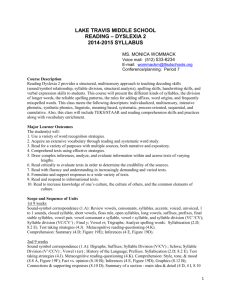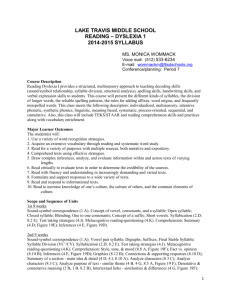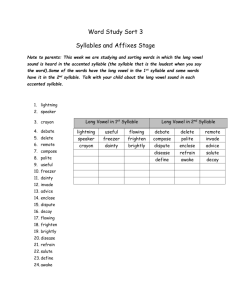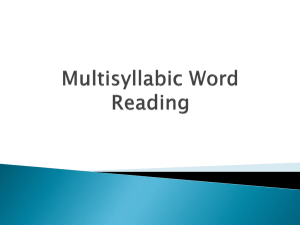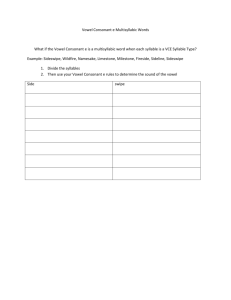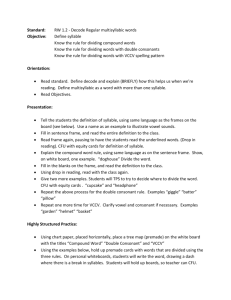Course Syllabus 2015-2016 Teacher Name Teacher E
advertisement
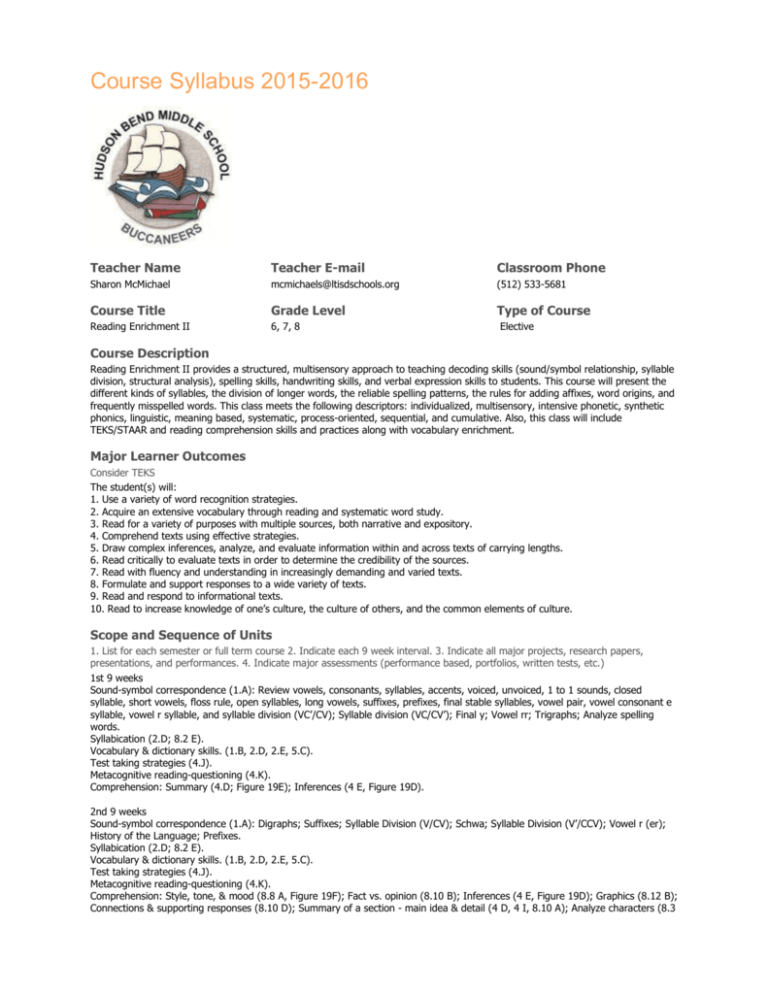
Course Syllabus 2015-2016 Teacher Name Teacher E-mail Classroom Phone Sharon McMichael mcmichaels@ltisdschools.org (512) 533-5681 Course Title Grade Level Type of Course Reading Enrichment II 6, 7, 8 Elective Course Description Reading Enrichment II provides a structured, multisensory approach to teaching decoding skills (sound/symbol relationship, syllable division, structural analysis), spelling skills, handwriting skills, and verbal expression skills to students. This course will present the different kinds of syllables, the division of longer words, the reliable spelling patterns, the rules for adding affixes, word origins, and frequently misspelled words. This class meets the following descriptors: individualized, multisensory, intensive phonetic, synthetic phonics, linguistic, meaning based, systematic, process-oriented, sequential, and cumulative. Also, this class will include TEKS/STAAR and reading comprehension skills and practices along with vocabulary enrichment. Major Learner Outcomes Consider TEKS The student(s) will: 1. Use a variety of word recognition strategies. 2. Acquire an extensive vocabulary through reading and systematic word study. 3. Read for a variety of purposes with multiple sources, both narrative and expository. 4. Comprehend texts using effective strategies. 5. Draw complex inferences, analyze, and evaluate information within and across texts of carrying lengths. 6. Read critically to evaluate texts in order to determine the credibility of the sources. 7. Read with fluency and understanding in increasingly demanding and varied texts. 8. Formulate and support responses to a wide variety of texts. 9. Read and respond to informational texts. 10. Read to increase knowledge of one’s culture, the culture of others, and the common elements of culture. Scope and Sequence of Units 1. List for each semester or full term course 2. Indicate each 9 week interval. 3. Indicate all major projects, research papers, presentations, and performances. 4. Indicate major assessments (performance based, portfolios, written tests, etc.) 1st 9 weeks Sound-symbol correspondence (1.A): Review vowels, consonants, syllables, accents, voiced, unvoiced, 1 to 1 sounds, closed syllable, short vowels, floss rule, open syllables, long vowels, suffixes, prefixes, final stable syllables, vowel pair, vowel consonant e syllable, vowel r syllable, and syllable division (VC’/CV); Syllable division (VC/CV’); Final y; Vowel rr; Trigraphs; Analyze spelling words. Syllabication (2.D; 8.2 E). Vocabulary & dictionary skills. (1.B, 2.D, 2.E, 5.C). Test taking strategies (4.J). Metacognitive reading-questioning (4.K). Comprehension: Summary (4.D; Figure 19E); Inferences (4 E, Figure 19D). 2nd 9 weeks Sound-symbol correspondence (1.A): Digraphs; Suffixes; Syllable Division (V/CV); Schwa; Syllable Division (V’/CCV); Vowel r (er); History of the Language; Prefixes. Syllabication (2.D; 8.2 E). Vocabulary & dictionary skills. (1.B, 2.D, 2.E, 5.C). Test taking strategies (4.J). Metacognitive reading-questioning (4.K). Comprehension: Style, tone, & mood (8.8 A, Figure 19F); Fact vs. opinion (8.10 B); Inferences (4 E, Figure 19D); Graphics (8.12 B); Connections & supporting responses (8.10 D); Summary of a section - main idea & detail (4 D, 4 I, 8.10 A); Analyze characters (8.3 C); Analyze characters (8.3 C); Analyze purpose of text - similar theme (4 B, 4 G, 8.3 A, Figure 19 F); Denotative & connotative meaning (2 B, 1 B, 8.2 B); Intertextual links - similarities & differences (4 G, Figure 19F); Author's purpose -comparison of 2 texts (8.9 A, 8.11 A); Text structure to locate recall information (8.10 C). 3rd 9 weeks Sound-symbol correspondence (1.A): Prefixes; Syllable Division (V’/CV); Prefixes; Latin Prefixes; Final stable syllable; Kind-old words. Syllabication (2.D; 8.2 E). Vocabulary & dictionary skills. (1.B, 2.D, 2.E, 5.C). Test taking strategies (4.J). Metacognitive reading-questioning (4.K Comprehension: Author's organization - cause & effect (8.10 C); Point of view (8.6 C). 4th 9 weeks Sound-symbol correspondence (1.A): Naughty e; Syllable Division (VC/CCV); Latin Roots; Greek Combining Forms; Syllable Division (V/V); Multisyllabic words. Syllabication (2.D; 8.2 E). Vocabulary & dictionary skills. (1.B, 2.D, 2.E, 5.C). Test taking strategies (4.J). Metacognitive reading-questioning (4.K). Textbooks and Other Major Resources The following texts and resources are provided to the student: Basic Language Skills, Book One, Neuhaus Education Center. Basic Language Skills, Book Two, Neuhaus Education Center. Scientific Spelling, Neuhaus Education Center. Six-Way Paragraphs, Jamestown Publishers. Grading Policy Please note the grading policy in the online HBMS Student Handbook at: http://c2.ltisdschools.org//Domain/56 Daily Grades 40%: minimum of 9 per 9 weeks. - Reading practices - Handwriting - Sentence dictation - 6 Way Paragraph stories - Vocabulary Word Web - Reading Comprehension Objective Practice (RCOP) Major Grades 60%: minimum of 3 per 9 weeks. - Review and or Mixed Lists - Reading Comprehension Objective Exam (RCOE) Relevant Reading and Vocabulary Lists Please reference the STAAR tab on my HBMS teacher website at: http://www.ltisdschools.org//Domain/555 Tutoring Times Tutorials are available before school from 8:15 A.M. – 8:40 A.M. on Monday through Friday. Students are welcome to visit with me during my morning duty on Fridays. After-school tutorials are available with advance notice. Homework Policy No homework is assigned in Reading Enrichment II. Conference Period 4th period Discipline Plan - Verbal warning to student. - Parent Contact. - Teacher consequence. - Referral to grade-level Assistant Principal. Please note that the severity of the infraction may change the severity of the consequence.
